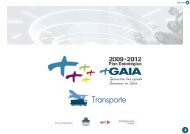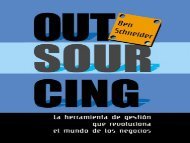The internet as a Rescue Tool of Endangered Languages ... - Gaia
The internet as a Rescue Tool of Endangered Languages ... - Gaia
The internet as a Rescue Tool of Endangered Languages ... - Gaia
You also want an ePaper? Increase the reach of your titles
YUMPU automatically turns print PDFs into web optimized ePapers that Google loves.
I shall now turn to some linguistic properties, first from a historical perspective. It is a<br />
longstanding tradition within Romance Philology to characterise Sardinian <strong>as</strong> the most archaic<br />
Romance language, that is to say, the language that h<strong>as</strong> best conserved some Latin elements. I<br />
shall briefly mention some <strong>of</strong> these characteristics. Consider the following examples:<br />
(2) Some <strong>of</strong> the so-called archaic elements <strong>of</strong> Sardinian<br />
DOMVS > domo not: c<strong>as</strong>a<br />
MAGNVS > mannu not: grande<br />
PILVM > pilu not: pelo<br />
CANTAT > cantat not: canta_<br />
'house'<br />
'big'<br />
'hair'<br />
'he/she sings'<br />
First, there is the conservation <strong>of</strong> some words that have been lost in all other Romance<br />
languages, like the noun domus or the adjective magnus. <strong>The</strong> words pilu and cantat show the<br />
preservation <strong>of</strong> the short Latin vowels I and U and the third person singular ending -T. Sardinian<br />
is interesting, too, from a synchronic, structural perspective. For example, in phonology, there is<br />
a peculiar copying-rule, which takes the l<strong>as</strong>t vowel <strong>of</strong> a word and copies it to the end into an<br />
empty segment (or pause): 4<br />
(3) <strong>The</strong> paragocic vowel and the underlying copy-rule<br />
cantat ['kantata]<br />
'he/she sings'<br />
bides<br />
'you see'<br />
['bidåzå]<br />
C V C V C V<br />
Sequence <strong>of</strong> vowels<br />
and consonants<br />
copy<br />
In syntax, we have similarly interesting movement rules that cannot be discussed here. 5<br />
<strong>The</strong> sociolinguistic status is that <strong>of</strong> a minority language before any legal establishment <strong>as</strong> a<br />
regional language. Sardinian is mainly spoken in the villages, in private life (both in the family<br />
or for non-<strong>of</strong>ficial contact within the village community). Italian is the main language in the<br />
cities, where<strong>as</strong> in the villages it is used for communication with strangers. In this respect, it is<br />
notable that Italian is also used to communicate with speakers <strong>of</strong> distant dialects <strong>of</strong> Sardinian.<br />
Italian is almost the only language used for <strong>of</strong>ficial purposes. According to data presented by<br />
EUROMOSAIC, there is a serious decline <strong>of</strong> language ability from one generation to the next: 6<br />
(4) Ability in Sardinian according to EUROMOSAIC<br />
Very good Quite good Little None NA<br />
Father 228,00 44,00 11,00 10,00 3,00<br />
Mother 224,00 44,00 13,00 14,00 1,00<br />
Brother 124,00 54 57 23 38<br />
Sister 108 43 51 24 70<br />
Mat GPs 248 16 3 18 11<br />
Pat GPs 246 18 4 12 16<br />
-2-







